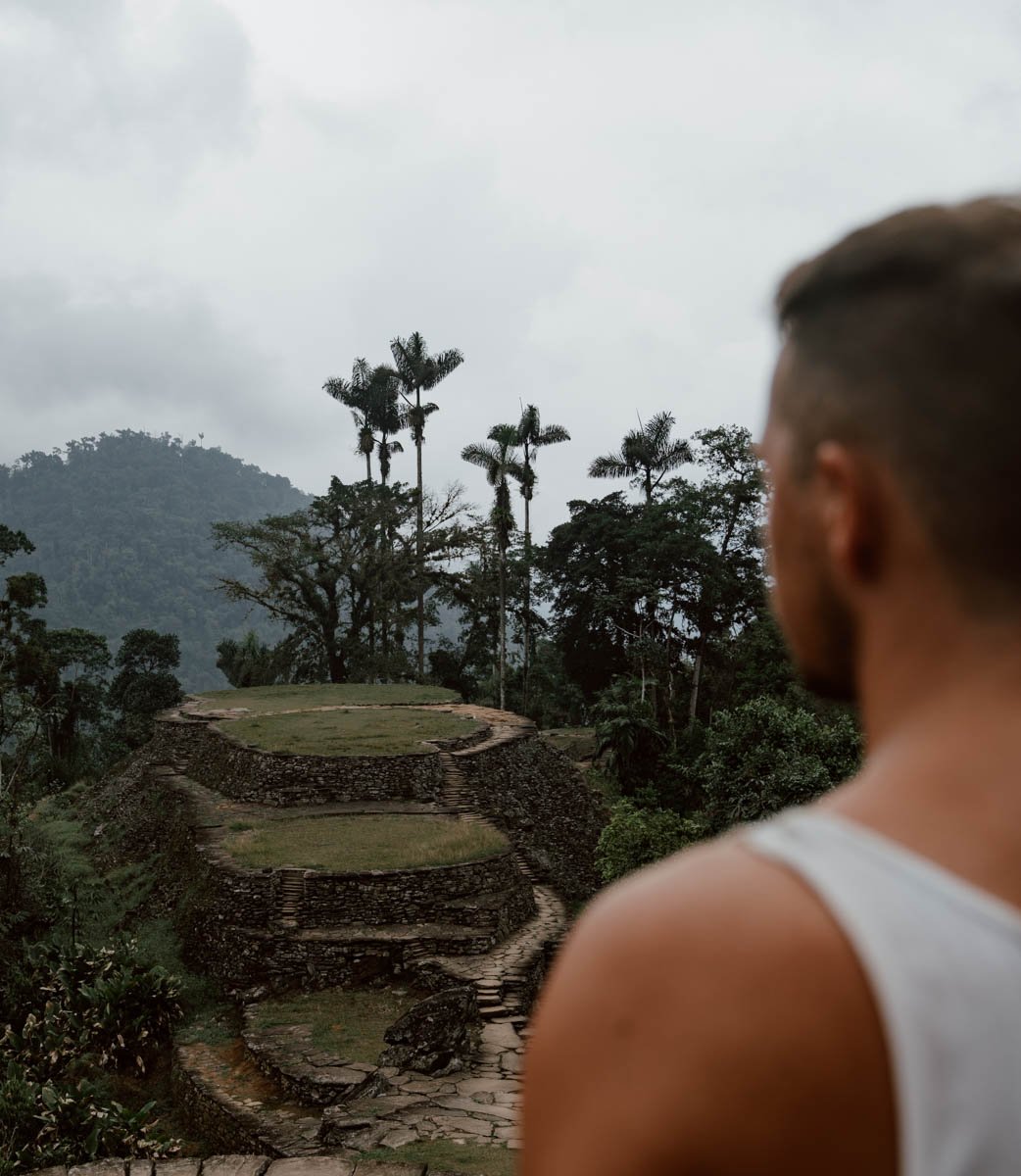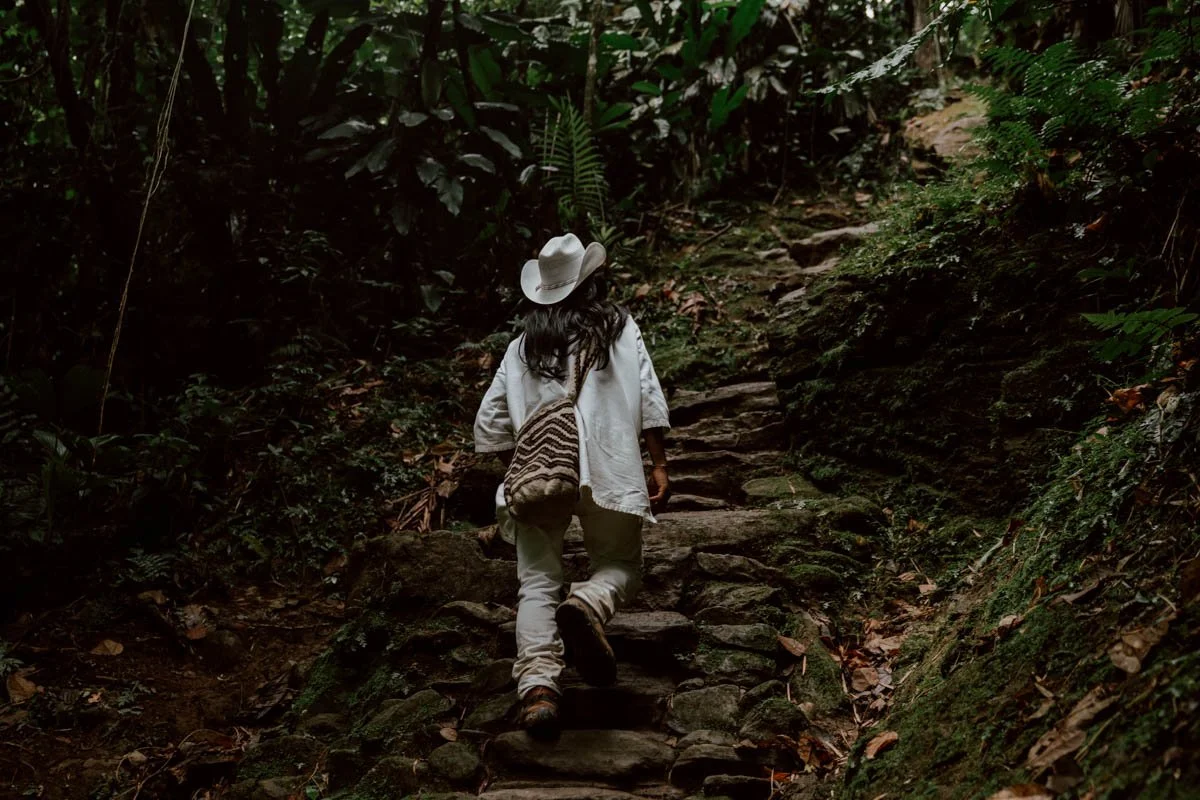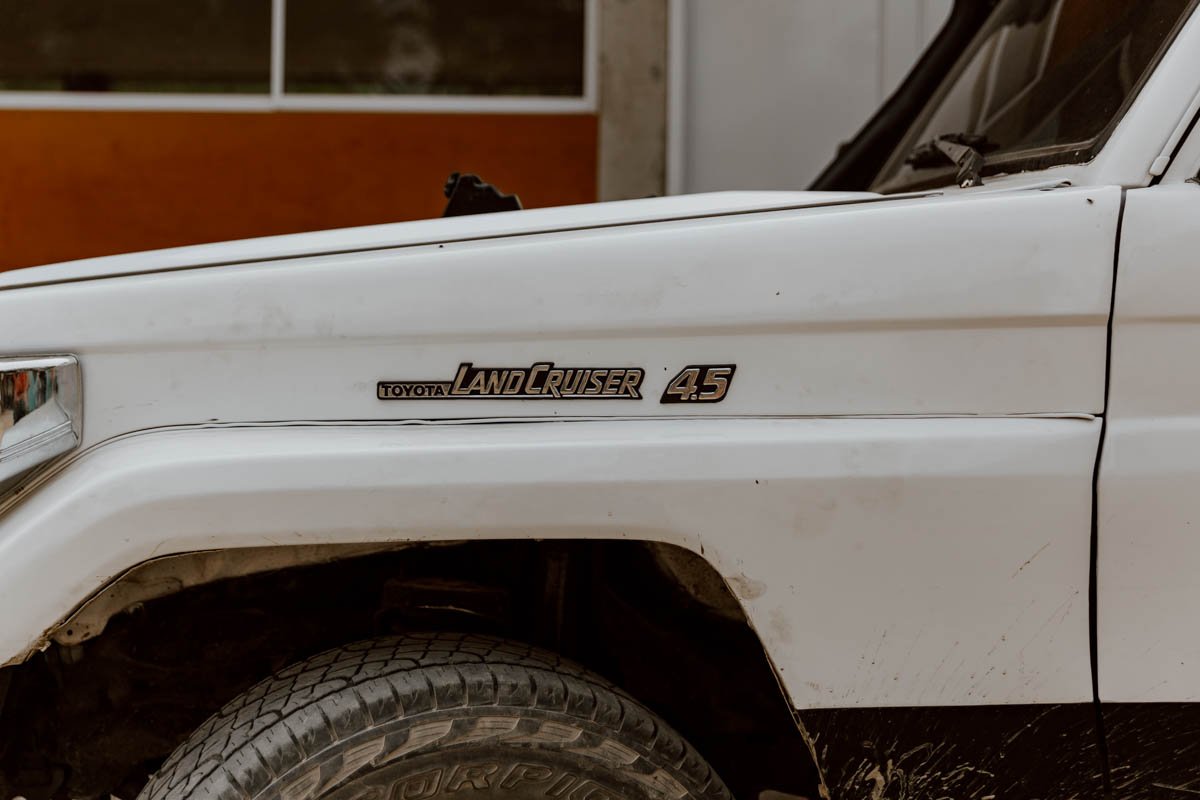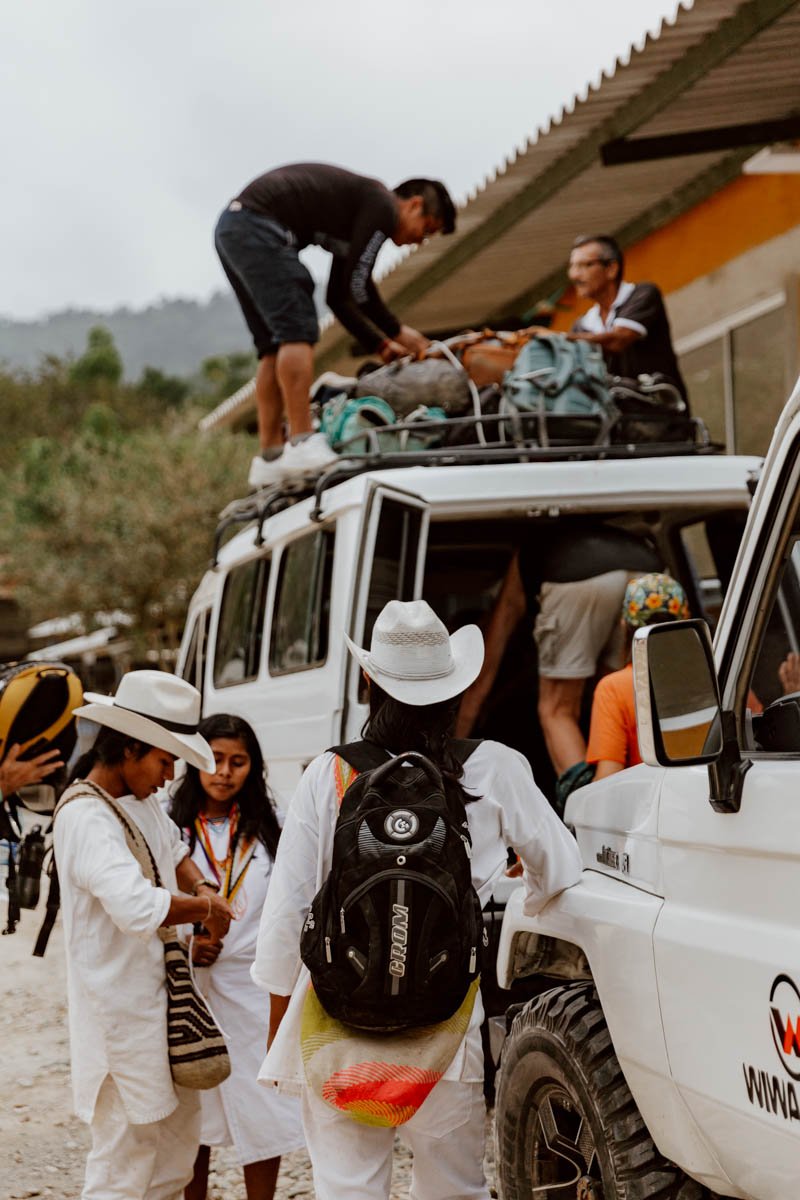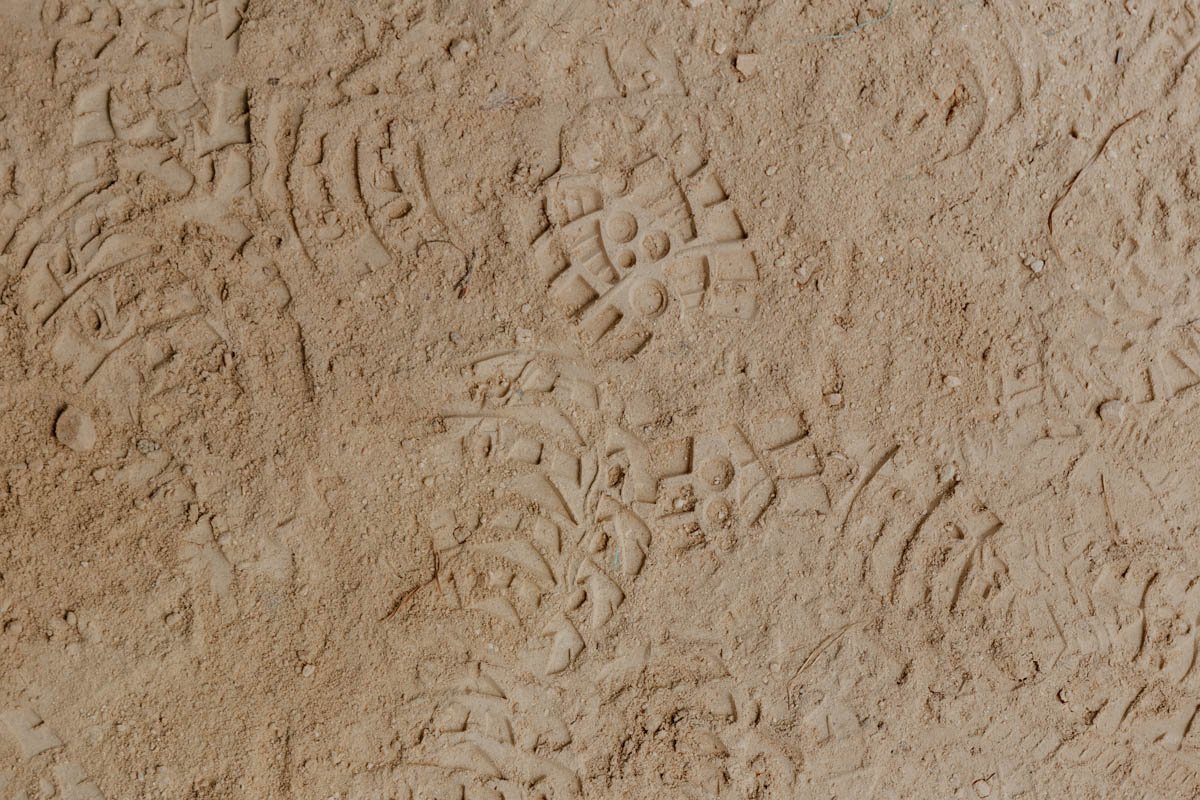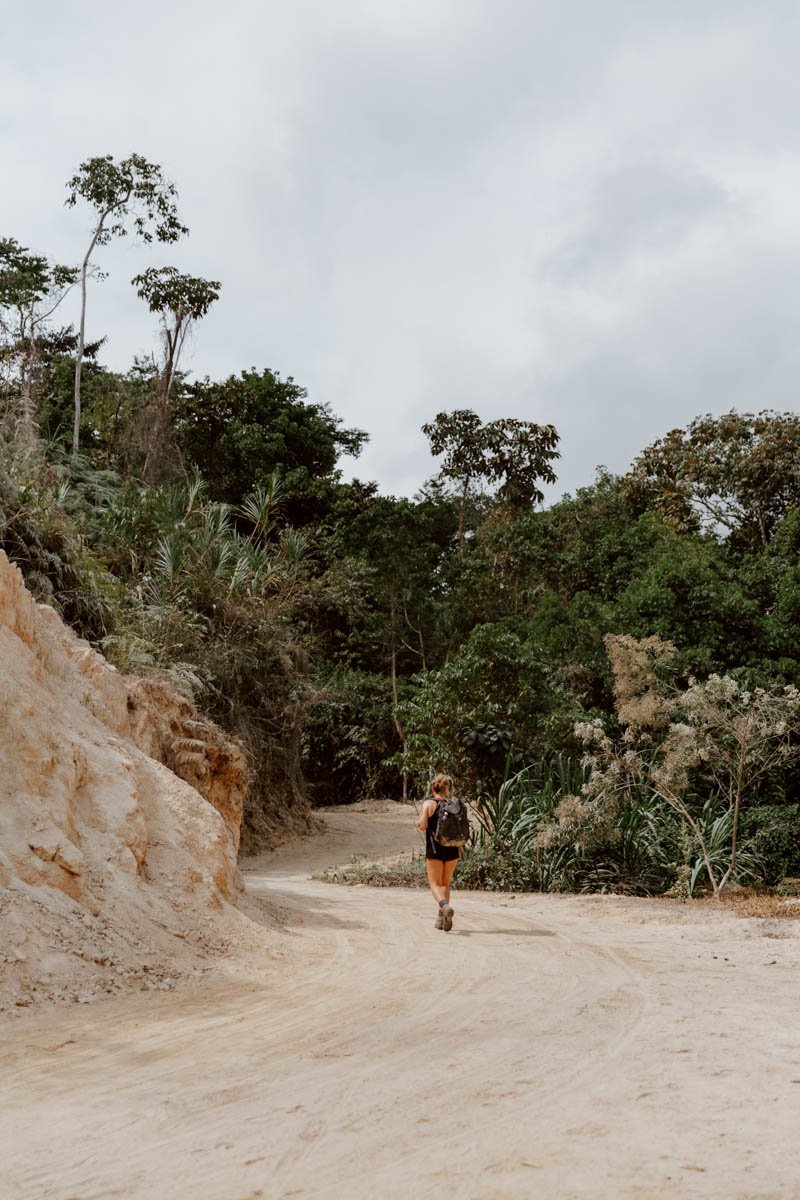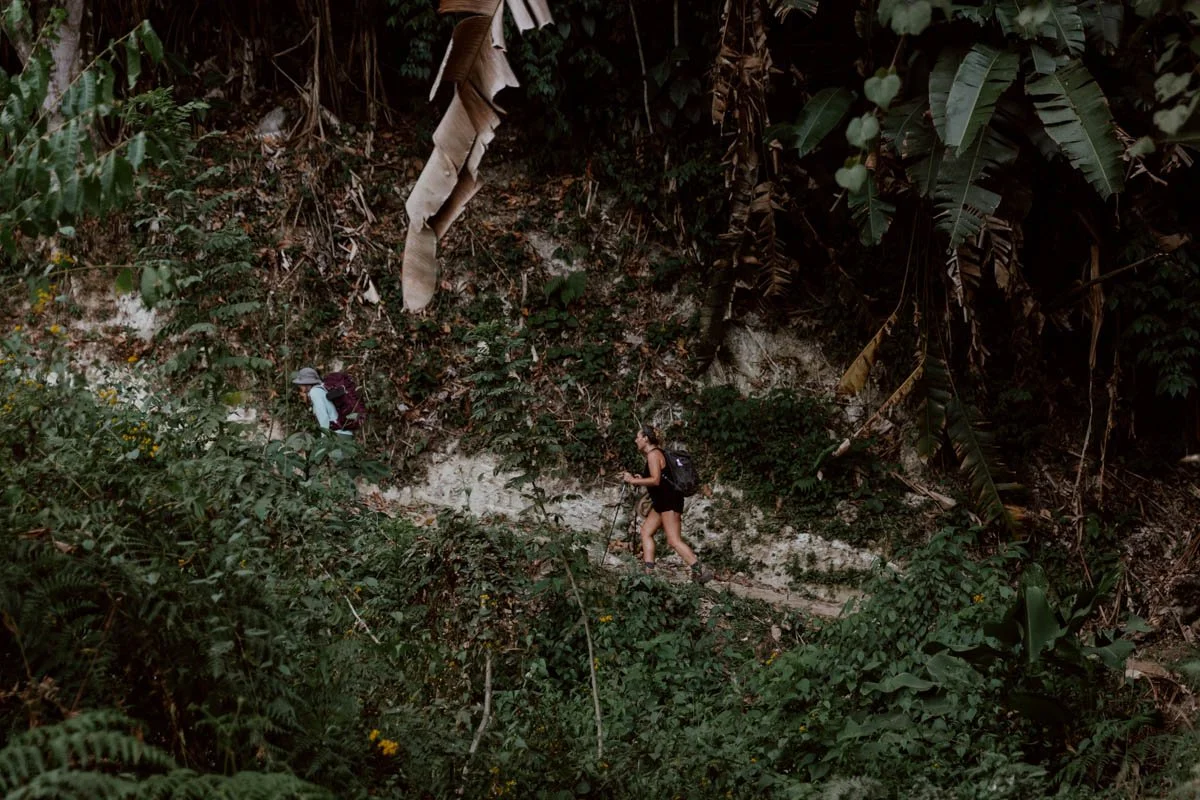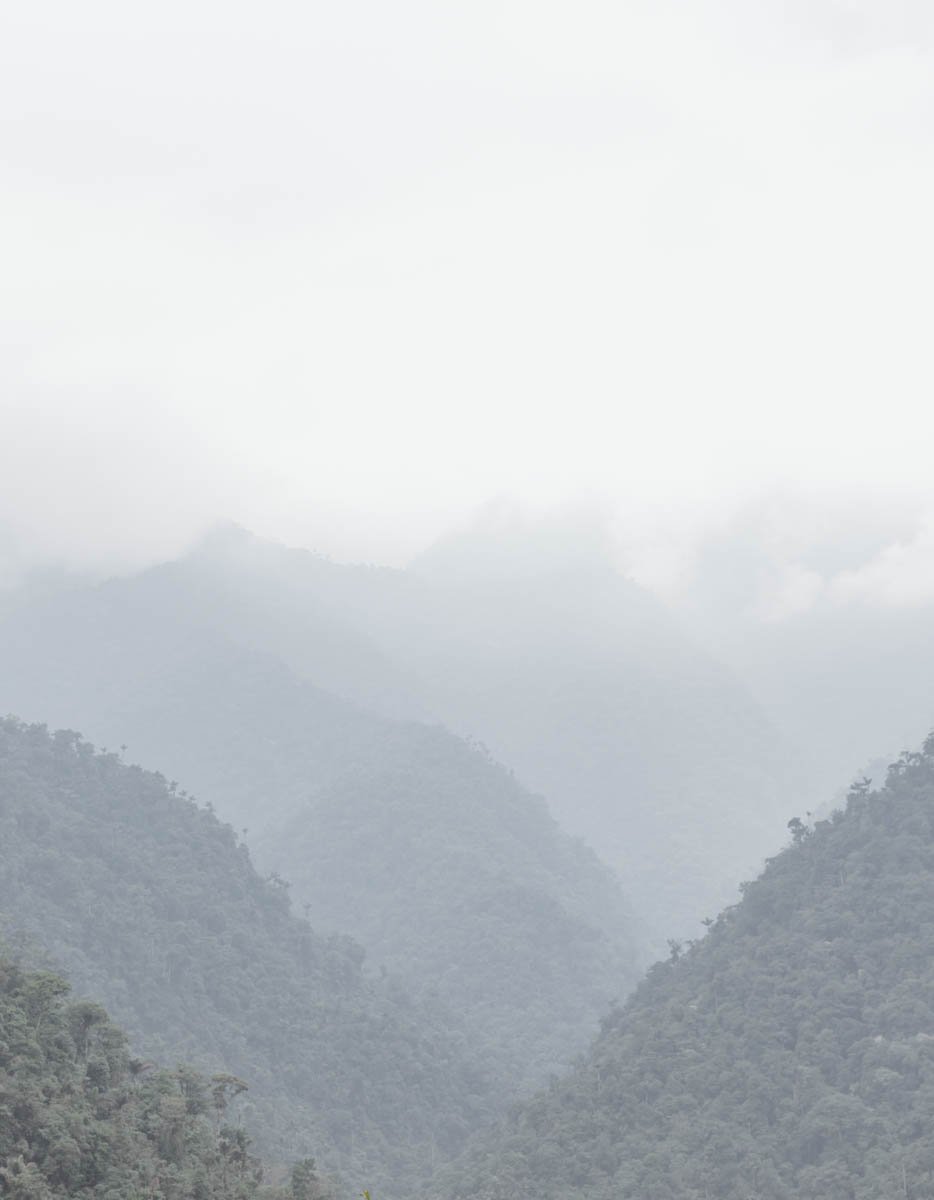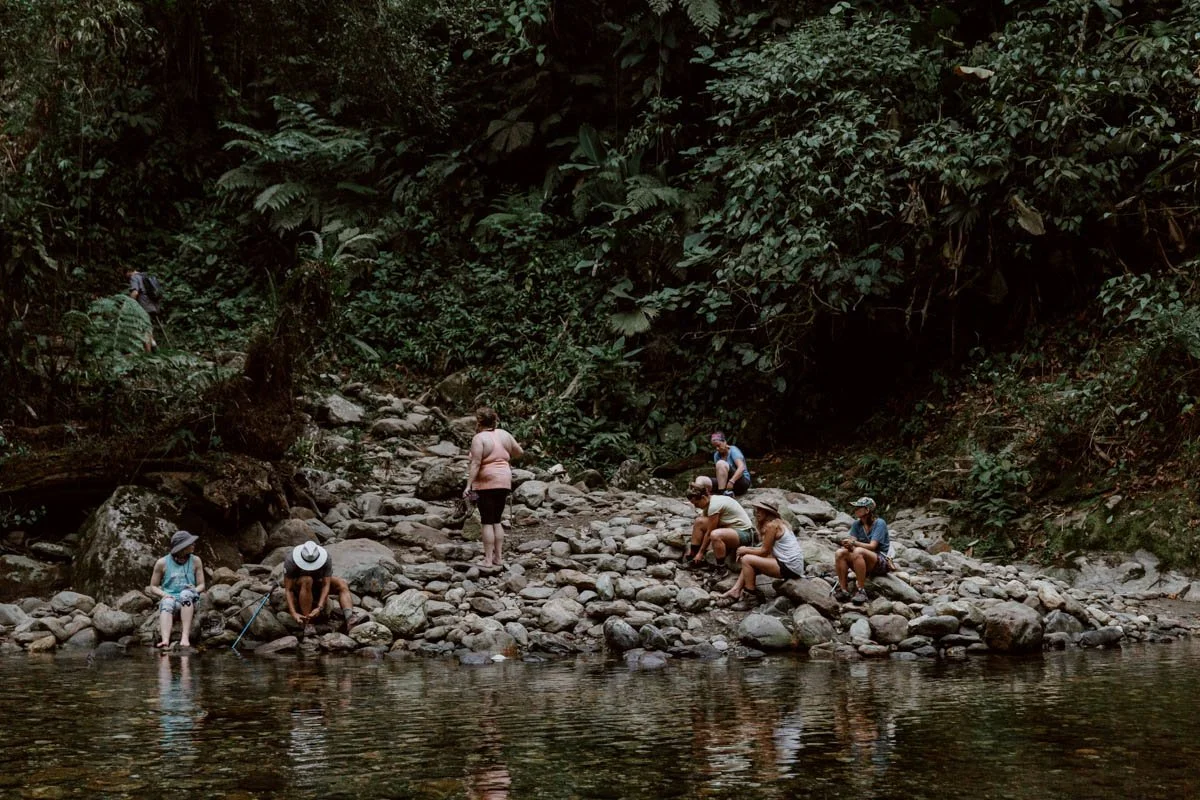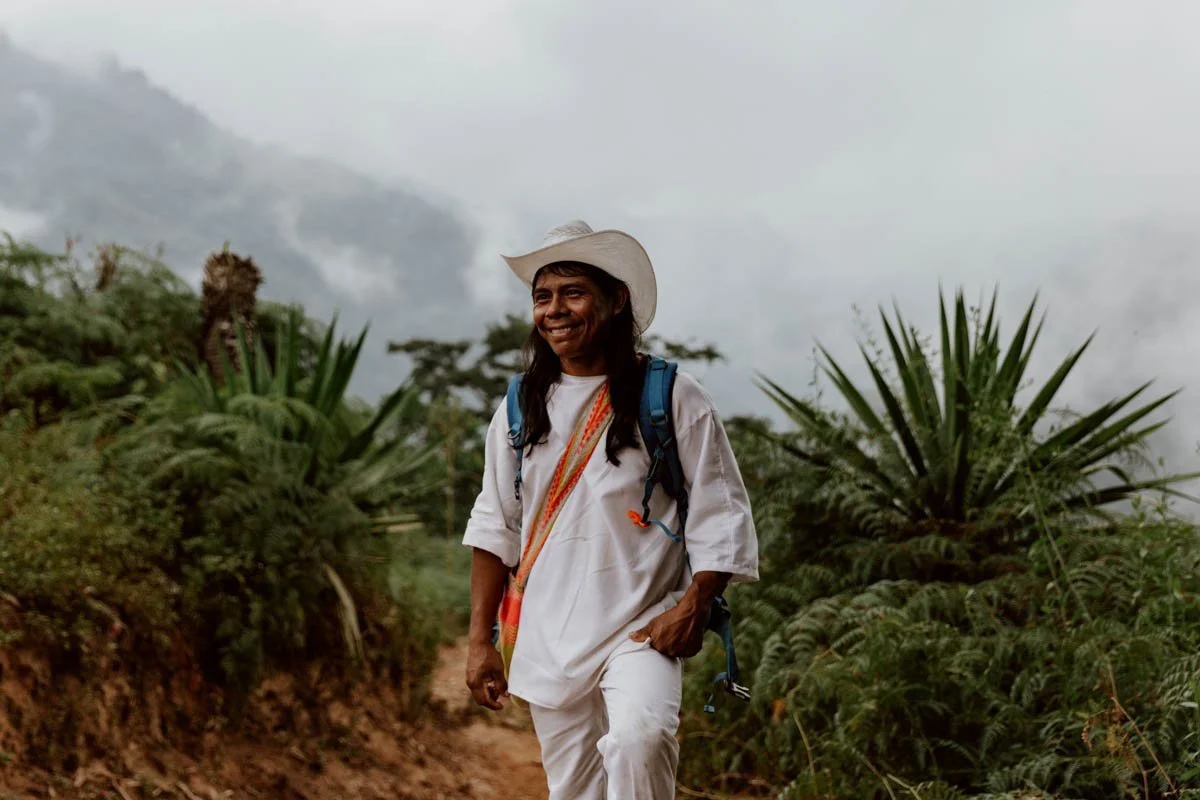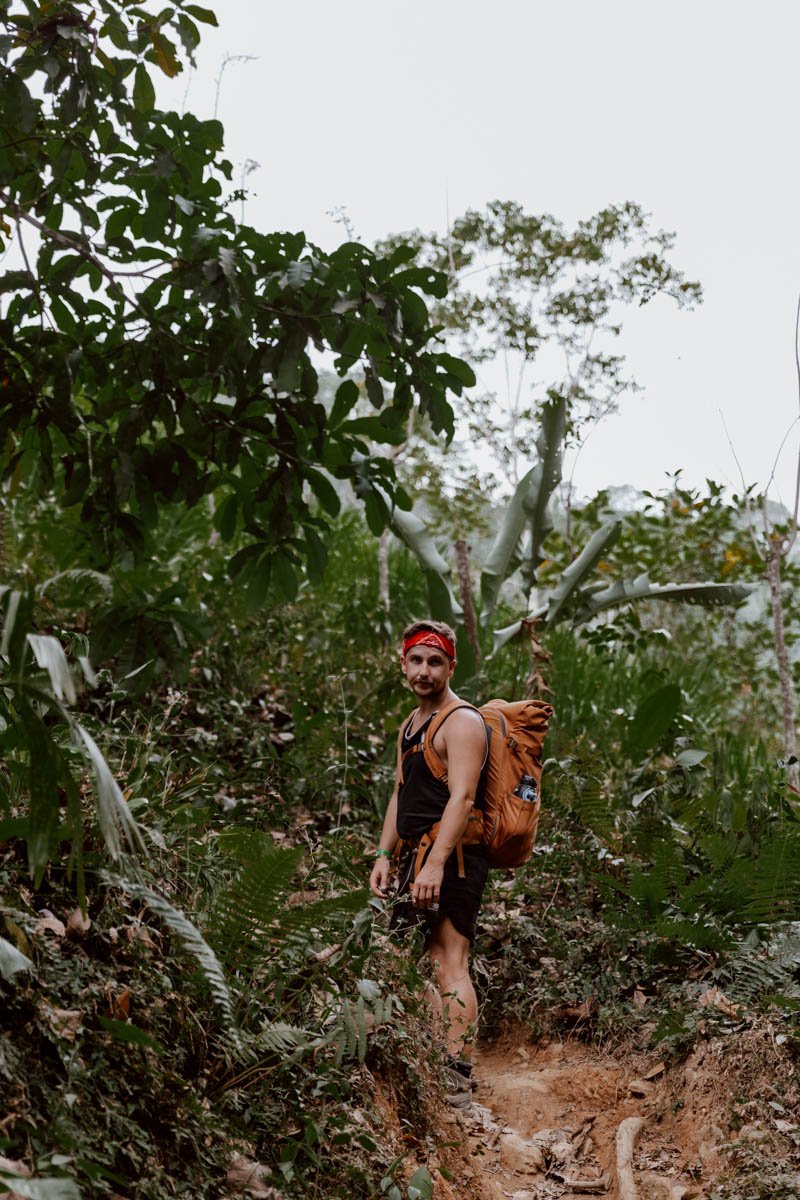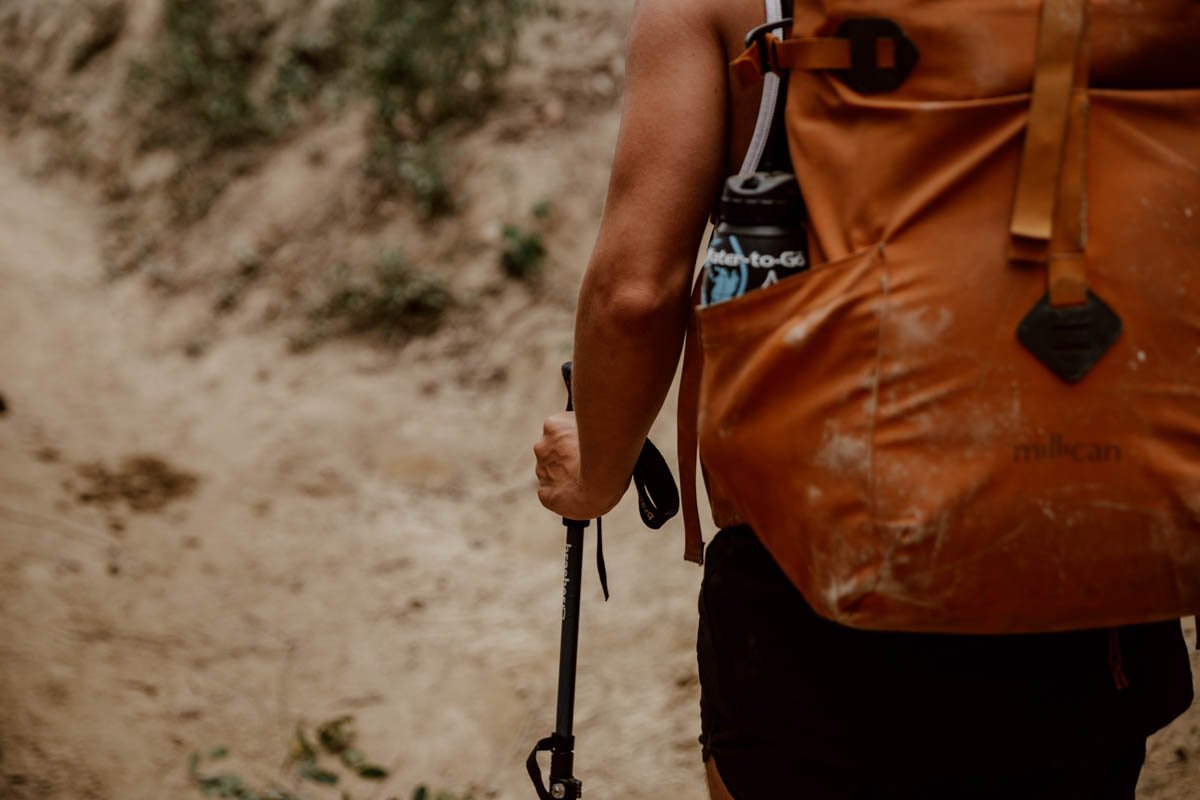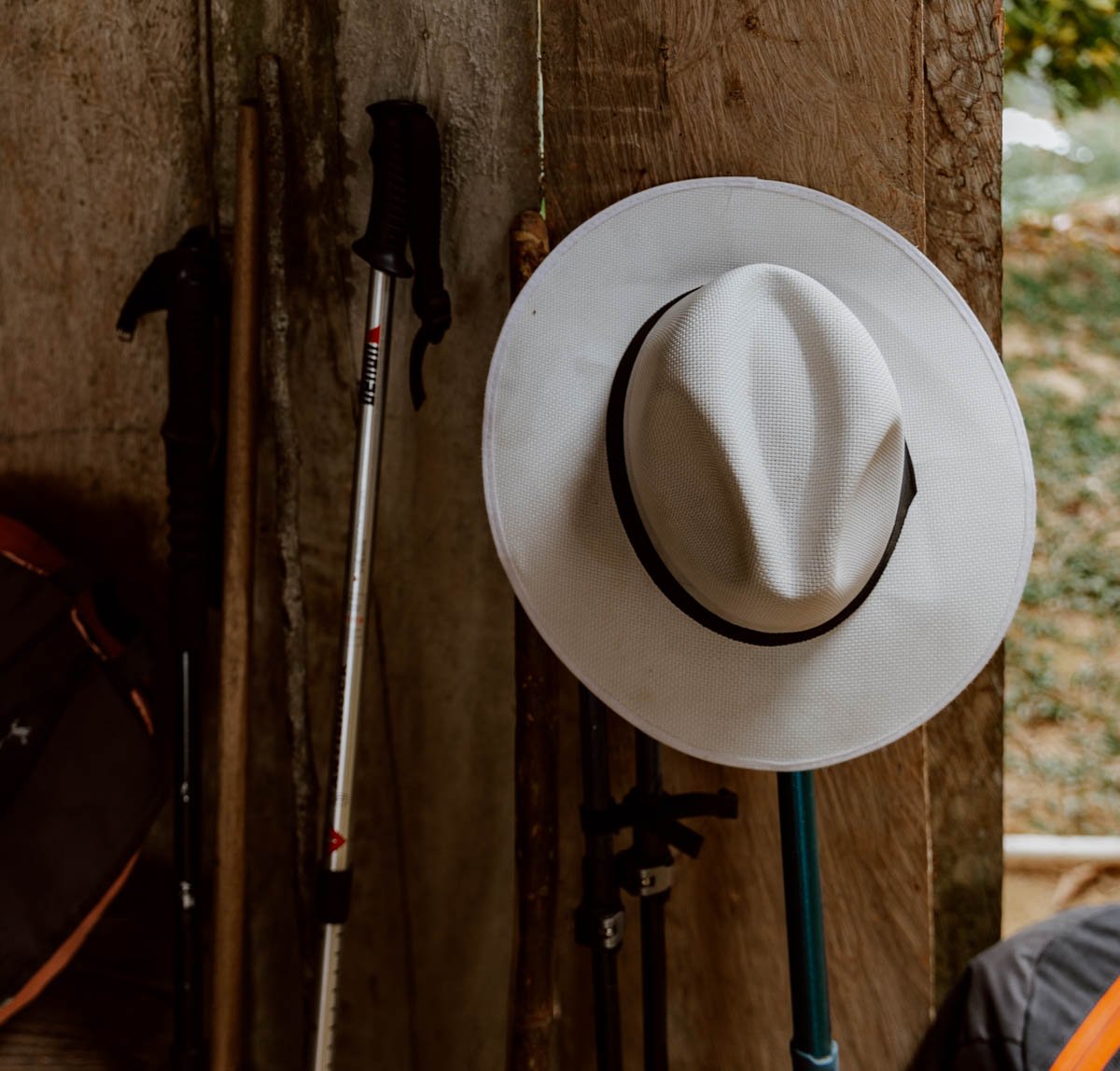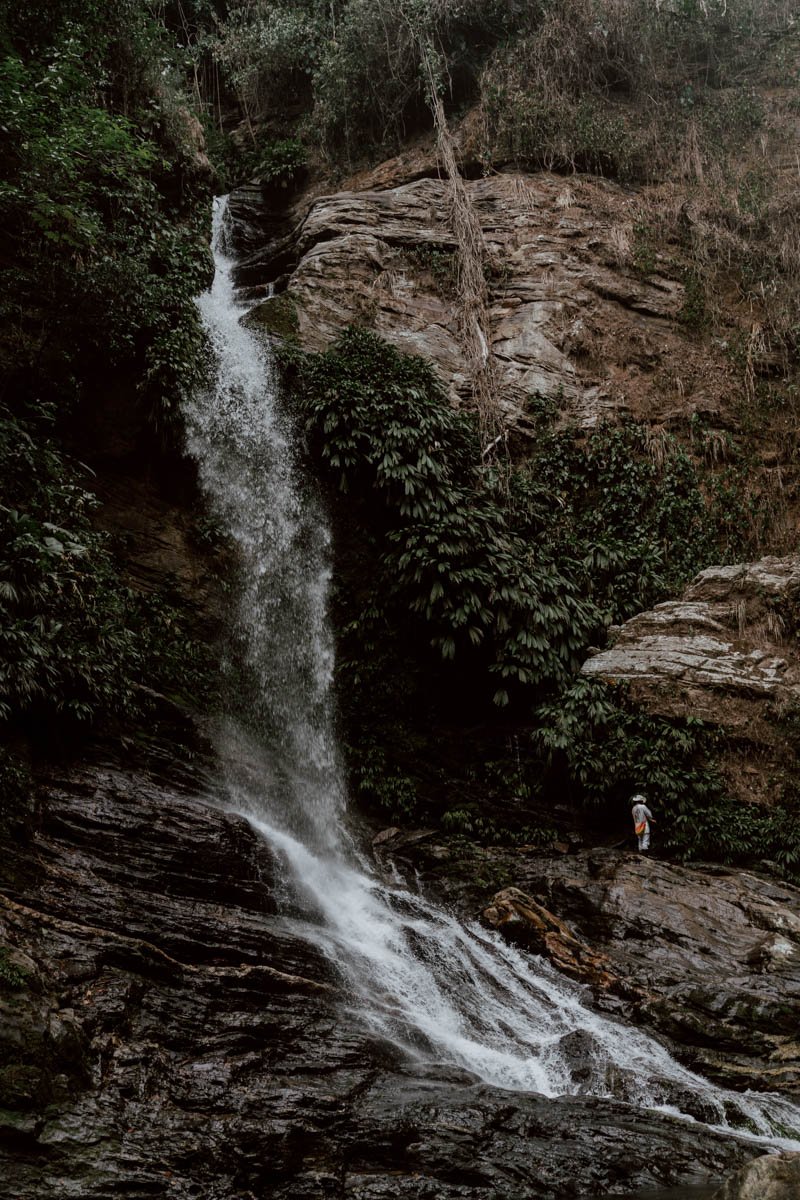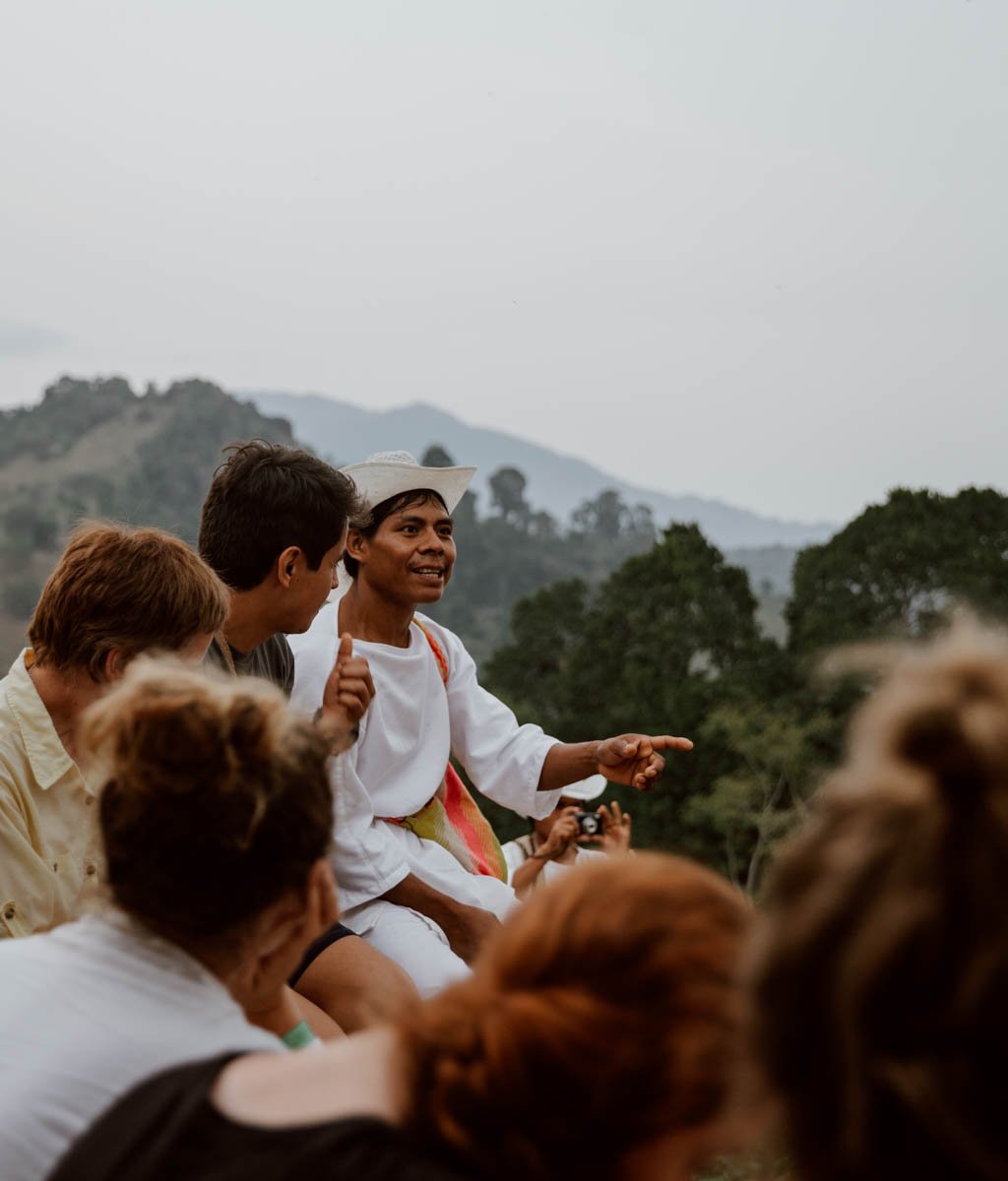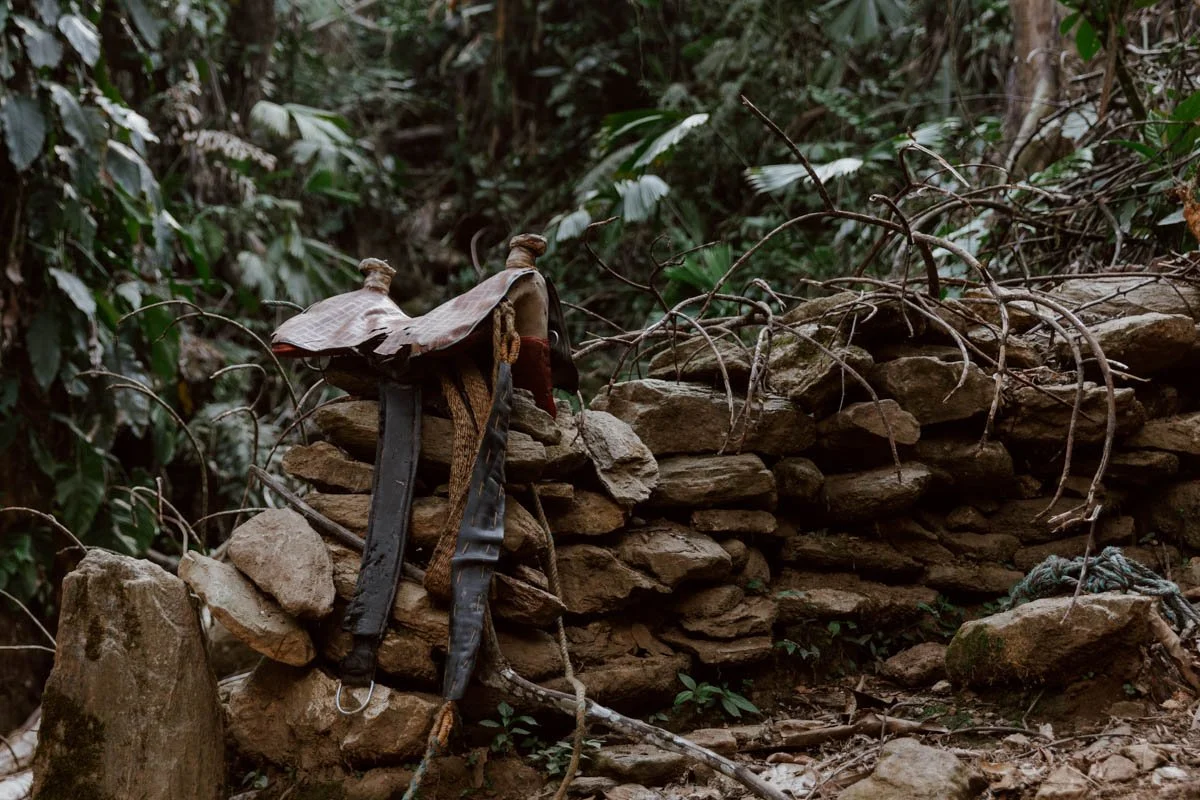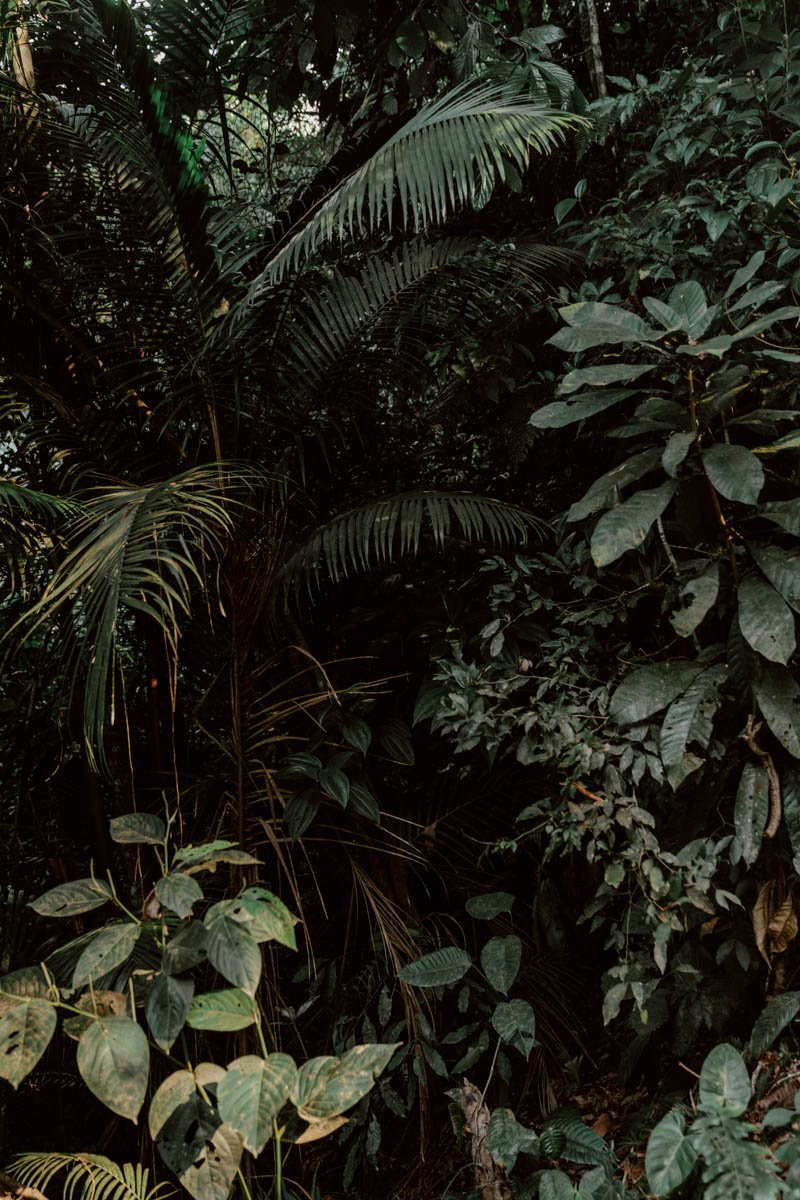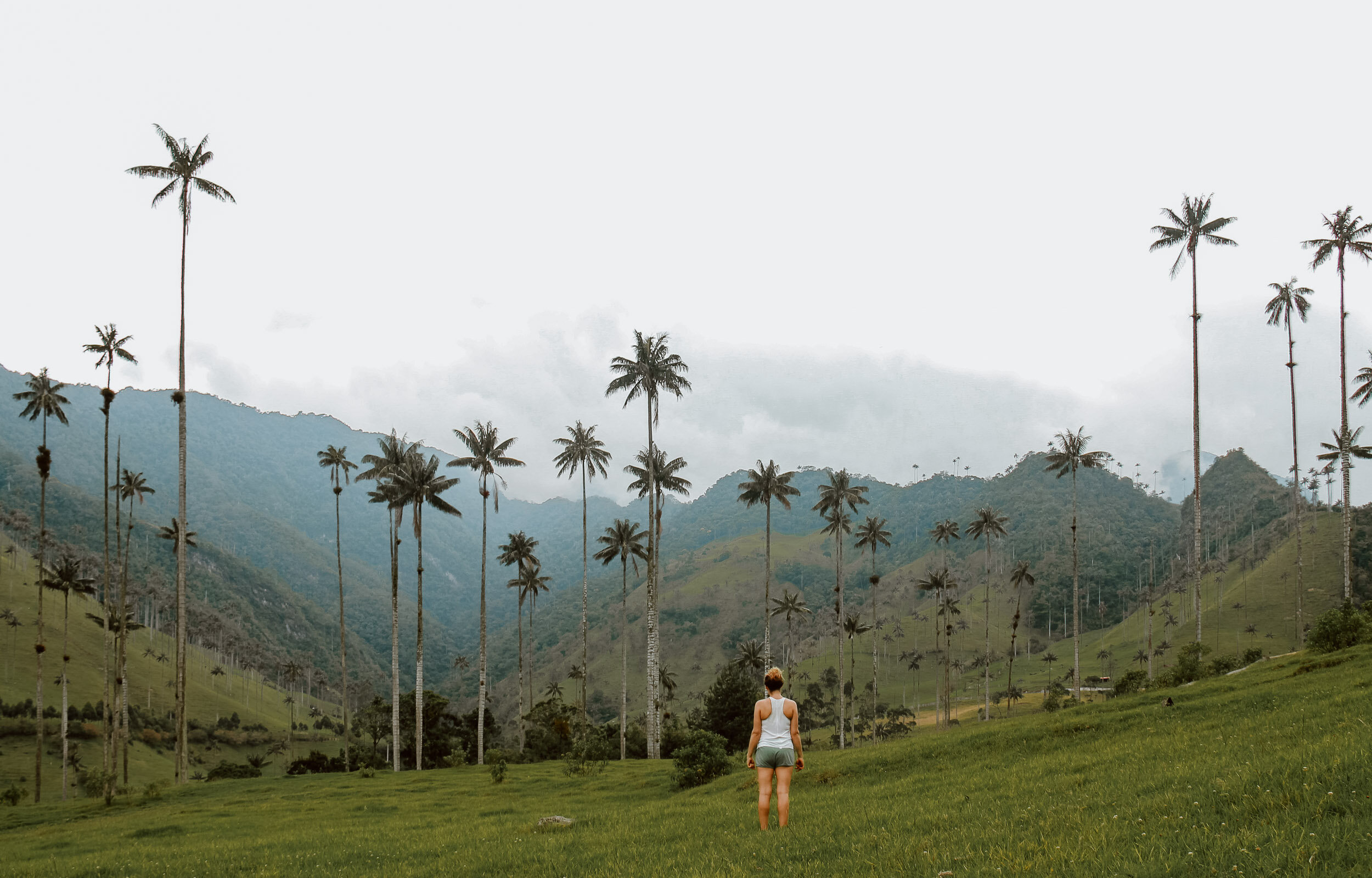The Lost City trek in Colombia is one of the most challenging hikes we’ve done in South America. To help you prepare for your own adventure in the Sierra Nevada with written this complete guide to trekking the Ciudad Perdida.
Updated January 2024
Colombia is not renowned amongst South American travellers for its hiking.
In a continent with unparalleled outdoors experiences, that accolade firmly resides with the snowcaps and valleys of Peru and Chile. Yet, deep within the northern jungles of Colombia’s Sierra Nevada de Santa Marta there lies a single trail which takes only the adventurous, the brave, and the curious towards a sacred site which is thought to be some 650 years older than Machu Picchu.
The multiday Lost City Trek (also know as La Ciudad Perdida) will see you compete with sticky humidity, early morning rises, stinky damp clothes, the odd blister, bug bites, and a cloistering heat. You will struggle, you will sweat, and you will ache on this uniquely challenging trek which isn’t necessarily for everyone.
But in doing it, you will find that the greatest adventures (and rewards) in life are the ones that make your work for them. And maybe you’ll also find out a little bit more about yourself as you make your way to that famous jungle ruin.
These are 23 things we think you really need to know before taking on the Lost City Trek - from how to prepare, what to pack, things to avoid on the route, and personal tips on how to minimise some of its toughest surprises. If you’re thinking about doing it during your upcoming trip in Colombia, or have already booked but are a little unsure of the details, then you’ll find all the answers here (but don’t worry, we’ve made sure that the trek’s best secrets are left out there on the trail waiting to be discovered by you).
lost city trek essentials
What / Multi-day jungle hike to ‘a lost city’ of the Tayrona people built in 800 AD, beginning from Santa Marta
Distance / 48 - 63 kilometres
Duration / Usually four days & three nights
Difficulty / Heat, humidity and incline mean that if you’re not fit, don’t attempt this trek
When / Best to avoid rainy season (May - Sept)
Book / Must arrange in advance. Can book online with G Adventures (like we did) / with an alternative company, or on arrival to Santa Marta
It is Not An Easy Hike. Seriously
Not that long ago, our G Adventures Lost City Trek was rated a four out of five (for its difficulty level). Our tour guide Felipe, after encountering many in his groups completely unprepared for the hike and individuals needing to turn back, insisted this be increased to a five.
He was totally right to do this.
Whilst the physical aspect of hike itself is by no means the most difficult we have undertaken in South America (especially as it’s not at high altitude), once you throw in the heat, the humidity, the sleeping conditions, the early mornings, and general jungle life, the Lost City Trek quickly climbs up the rankings as one of the most challenging things we’ve ever done.
Though it’s almost impossible to properly prepare for the humidity, we really wouldn’t recommend attempting this hike without ensuring that you’ve done all you can to obtain a good level of fitness. Over the four or five days, you will personally hike 48-63 kms and this does take its toll towards the end. There are motorbikes and mules available to rent at various points or in the case of emergencies, but if you begin the hike suspecting that you will have to utilise them, it’s probably a good indication that you may not be up to the trek. This is, after all, the middle of the nowhere and your options are very limited if you can’t continue.
However, before you get totally disheartened or scared off, we have to note that there were several mature trekkers in our group and in other groups who completed the Lost City without issue! A positive mental attitude and a willingness to take on new experiences or environments over the four or five days are as essential to completing and enjoying the route as your decent level of fitness.
And That’s Before You Get To The Steps
There are 1200 steps to climb before you make it to the entrance to the Lost City site itself.
1200 ancient steps from the Buritaca River that are incredibly narrow, incredibly steep and, even in dry season, incredibly slippery - the only members of our group to climb them with any speed or grace were our Wiwa guides, Rafael and Felix, and our hike-dog, Gordon.
Take them slowly, and with care, especially when descending. If there are other groups on them, then respect each other’s space and pace as serious accidents have occurred here and, well, you really don’t want a serious accident here.
Travel Tip // Travel insurance is necessary for this trek and for your trip in Colombia - find out common mistakes to avoid when buying your policy here.
Santa Marta Is An Integral Part of Your Route - And Where You’ll Store Your Stuff
The city of Santa Marta, situated on the Caribbean coast of Colombia, is the main jumping off point for each and every single Lost City Trek. At 4 hours from Cartagena, it’s easy to reach with a bus, and is likely going to be a stop on your itinerary before or after Palomino, Tayrona, and Cabo de la Vela.
As the first day of the trek begins quite early, and you will not return back to the city until late afternoon on your final day, any Lost City Trek will almost certainly require a night in Santa Marta either side of your hike.
Our tour with G Adventures included pre-arranged hotel accommodation for both these nights, as well as luggage storage - for most other tour companies you will have to source and arrange these separately. Most accommodations in Santa Marta will provide free luggage storage (that is, they will have a locked room to store your bags), but do not provide individual lockers to securely store your valuables - this makes most insurance policies null and void in terms of coverage in the event of a loss.
In true Along Dusty Roads style however, we came up with a solution! We contacted over a dozen hostels in Santa Mata to find somewhere which offers secure lockers in addition to the bag storage, and are delighted to recommend La Guaca Hostel. This did mean that we had to spend an additional night in Santa Marta (prior to moving to our pre-arranged G Adventures accommodation), but being able to confidently leave our laptops and spare camera equipment somewhere secure was more than worth it.
Keep Reading // Plan for your time in Santa Marta with our travel guide.
It Has To Be Done With An Approved Tour Company
We love doing hikes independently, and it’s been our go-to option on so many of our adventures in South America. However, just like Peru’s Inca Trail, you can only do the Lost City Trek as part of a booked tour with one of several approved tour companies; it is not possible to do this hike independently and it is not possible to reach the Lost City by any other means except the established multiday hike.
Unlike the Inca Trail, you don’t have to book months in advance and there is usually availability for booking made only a few days before the departure. However, if you know your travel dates and will only be in Colombia for 2-3 weeks, then it makes sense to book in advance.
In addition to Felipe, our fluent English-speaking G Adventures guide, our group of 15 was led by Rafael - a 22-year old Wiwa guide - for the duration of the trek. This made the whole experience much richer, much more meaningful, and much more memorable, as well as greatly adding to our cultural understanding of this place, its history, and the people who live here. As well as making the the trip about something more than just the hike, involving the local communities in a positive and impactful way is the only way that the increasing popularity of Lost City trek can be managed in a sustainable and responsible manner.
Not every tour company will be led by a local indigenous guide, and we would encourage you to only go with a tour company which involves and includes the indigenous communities who have called this small part of the world home for their entire existence.
To find out more about the G Adventures Lost City Tour and how they work together with local communities, click here.
The Prices Have Gone Up Quite a Bit
So, if you’re a backpacker on quite a tight budget, this is where some decisions may need to be made…
Whilst on our first visit to Colombia way back in 2015 you could complete the Lost City trek for around £150 all in, prices over the years have gone up quite significantly - the pandemic didn’t help, but the country’s general increase in popularity is the root cause.
The tour that we took with G Adventures now costs £549. Whilst you have to consider the fact that this includes two nights accommodation in Santa Marta (at the beginning and end of your tour), that the experience is indigenous-led and directly benefits the local communities, and the company has some great ethics, there’s no denying that this is a pricy activity.
For those that have just spluttered all over the screen, don’t worry, more affordable tours can be sourced! If you’re a planner and would like your Lost City trek to be booked in advance, consider this highly-rated and super popular four day / three night option via Viator (seriously, it has more than 1,700 5* reviews) that costs £370.
Alternatively, if you are travelling slow don’t mind winging it, your cheapest option is to turn up in Santa Marta and source a tour directly from one of the companies in town. Whilst you may have to kill a couple of days whilst waiting for the departure, by doing this you should be able to secure a similar tour to the one above for around £300.
It’s A Four Or Five Day Route
Our hike was quite unusual in that it lasted four nights / five days instead of the standard three nights / four days.
Most tour companies take two days to get to the Lost City, with a couple of hours spent exploring the ruins on the morning of the third day before turning around and spending one last night on the trail before driving back to Santa Marta on day four. It generally looks like this and usually involves a wake-up call between 5 am - 7 am each day:
Day One: Transport from Santa Marta + 3-5 hours hiking + night on trail
Day Two: 7-9 hours hiking + night on trail
Day Three: 1-2 hours hiking + Lost City site visit + 6-8 hours hiking + night on trail
Day Four: 5-7 hours hiking + transport to Santa Marta
This route generally encompasses 48 - 50 kms, but thankfully does not involve the high altitudes of many other South America treks (the highest points are 900 - 1,200m). All your meals and accommodation on the trek will be included, alongside transport to/from Santa Marta and entry to the Lost City.
Our route with G Adventures was however a little different. We reached the Lost City along the same route as the other groups, but after the ruins our pace slowed and we spent a fourth night on the trail. On the fifth day, we took an exclusive off-the-beaten path trail to visit an excellent Planeterra project in a village called Gotsezhi to help support and develop sustainable community-led tourism and take in some incredible untouched scenery.
See the full itinerary with G Adventures here.
And It’s Not A Loop
One of our personal bug-bears: having to re-trace our steps on a hike.
But for this particular trek, there’s absolutely no other option but to go back from whence you came! There is only only path which leads everyone to the Lost City site, and one path back from it (unless you take the exclusive five day option like we did).
On the plus side, those horrendous climbs on the way there will at least be all down on the way back!
A couple we met in Jericó before we did the trek said that they found it boring having to walk back the same way they came and so most of their group tried to move as quickly as possible. Given that it’s something that frustrates us too, we thought their advice would be sound; turns out, we couldn’t agree less.
Sure, it’s a bit annoying having to go back the same way on any hike, but those extra two or three days spent walking in the sights and sounds of the rugged Colombian jungle - and in one of the world’s most important ecological systems - should be savoured and experienced with a mind open. We are, after all, incredibly lucky to be able to walk a trail and in lands which were once cut off to the world for so long - it would be silly to rush it or take it for granted.
Yes, There Will Be River Crossings
From ankle deep cool water in the dry months, to gushing thigh-high torrents of water at the peak of the rainy season. Either way, you’ll have to whip off your boots at least a few times during your time in the Sierra Nevada!
Whilst we chose to embrace bare-feet, several members of our group opted instead for water-proof sandals like these for the crossings which then doubled-up to be their ‘around the camp’ shoes. We did however choose to bring our yellow 10l drybag as an added layer of protection for our cameras (but it almost certainly wouldn’t be necessary for people travelling without technology).
We found these crossings to be a lot of fun - and a welcome relief from the heat - but please do take care on them and pay attention to what the guide tells you about the best way to cross (as not all involve ropes).
Travel Tip // There are several waterfalls and pools along the Lost City Trek, and most tours will include an afternoon dip in one of them, so don’t forget to pack your bikini or swim shorts - see our Lost City Trek Packing List for more advice.
Not All Seasons Are Created Equal
If you are including the trek as part of a longer South America adventure, you’re unlikely to have much say in when you do the hike - it’ll just be ‘when you get to Colombia’. If however you’re heading to this part of the world for a much shorter trip, you’ll want to consider weather conditions before booking.
The northern part of Colombia has two seasons - dry and wet. Both are incredibly hot and incredibly humid, but between the months of May and September you can add torrential downpours into the mix. People continue to do and enjoy this trek in the wet season - including a friend who enjoyed her rainy experience so much last time, that she wants to do it again - but it is not without its challenges.
Dirt paths become knee-deep mud, descents seem better taken on your bottom, and river crossings go from fun to occasionally terrifying. If you’re concerned that you might not be in good enough shape for the hike, consider limiting yourself to doing it in the dry season.
The Jungle Is Home To Many; Be Respectful
Towards the end of the first day’s hike, the landscapes begin to change. Vegetation thickens, farmland reduces and the jungle beckons; by late afternoon you will enter Wiwa land.
This indigenous group, one of the four that call the Sierra Nevada home, have existed for centuries. They have survived through colonial conquering, attempts to ‘civilise’, and the cocaine conflicts often forcing them from their lands, and to this day, continue to live a very traditional way of life.
Throughout the hike, you will pass many of these people, their homes and their families; please give them the respect that they deserve. Only take photos with prior permission and on the advice of your guide*, be courteous when you cross paths, but don’t be offended if you receive little interaction - many are incredibly shy and are still not used to foreigners on their land.
Additionally - and something that you should be doing wherever you are - take all your rubbish with you. This hike is only increasing in popularity, but the pieces of litter that we picked up along the way will increase exponentially unless we all take responsibility for our trash. You will find recycling and rubbish bins at the various campsites.
* All photos of Wiwa men in this post are of the Rafael and Felix, part of the group of excellent local guides who join and lead every G Adventures Lost City Trek.
You’ll Have A Few Hours At The Lost City (Which Was Never Really Lost)
The crescendo of the hike is, of course, your arrival into the Lost City site itself.
We were incredibly, ridiculously lucky to have the most magical experience we could ever have hoped for here. Through a combination of campsite availability, good trek pace, the season and weather, our group leader decided that we should visit the Lost City on the afternoon of our second day of hiking, rather than the usual morning of day three.
The result was that, apart from a troupe of doggies and the three army guys stationed there, we were the only souls at the famous site for the entire afternoon - pretty amazing in the days of Instagram huh? However, we know that this was definitely the exception rather than the rule, so expect your own visit to the Lost City site to last for two to three hours, take place on the morning of your third day, and to involve a few other groups (access to the site is limited to 150 people per day).
As ever, please be respectful of the site, leave only footprints, and take only memories and photos.
Rafael, our local Wiwa guide, gave us our group a cleansing ceremony prior to entry so that all our negative thoughts and emotions were left behind on the 1200 stairs before taking us through some of the secrets and history of La Ciudad Perdida. Around 90% of the site continues to lie under thick jungle, and we were surprised at how vast it feels beyond the most famous backdrop.
Throughout our time with Rafael, he was passionate about sharing the fact that this Lost City - built by the Tayrona civilisation - was never actually lost to the indigenous people who live here in the Sierra Nevada. He told us that the mamus (shaman) of the communities here always knew of the site and visited it for centuries, and the looters and robbers of the 1972 simply ‘rediscovered’ something that the outside world had forgotten existed (or had never been told).
Bug Spray! Bring All The Bug Spray!
Mosquitos, gnats, tics, spiders and even one particularly menacing scorpion - the Lost City Trek is not lacking in creepy crawlies.
Completing the hike in dry season meant that there were far fewer mosquitos about, but it probably increased the number of tics we encountered. Poor Andrew got covered in so many of the little buggers, and most of our group ended up with at least a couple attached to various parts of our body.
Whilst bug spray won’t protect you from the ticks, it is essential to cover yourself liberally in mosquito-repellant upon waking in the morning and at various times throughout the day. Just remember to apply your sun screen first, or it’s next-to-useless.
We highly recommend people purchase Incognito, which is a DEET-free, chemical-free bug spray which is not tested on animals and bloody works! Also, please be considerate of others and your surroundings when spraying bug spray - especially if you have the really nasty chemical ones. Nobody enjoys breathing them in and it’s important that you limit the amount in the air as plants in the jungle need those bugs to crawl all over ‘em, even if you don’t (tip - the best way to spray is to apply directly into your hand and rub it on your body).
Oh, and always remember to check your boots in the morning before you put them on - you certainly don’t want to find a scorpion nestled in there alongside your tootsies! We did actually meet our very first scorpion even on this trek!
There Will Be Guys With Guns
If you’re heading to Colombia for the first time, chances are that you may be a little concerned about safety issues. However, please rest assured that the situation in this wonderful country has improved so much over the last two decades - we’ve spent five months in Colombia over two separate trips and not faced any issues (and this is the experience of the majority of visitors).
But on the Lost City trek, we were taken aback to see more young men with large guns than we have ever seen before.
One simply cannot go to Colombia without an appreciation of the traumas and complex conflicts which fragmented the country for most of the last 60 years. Although the signing of a peace deal in 2016 marked a significant step, peace in Colombia is a new and fragile thing. The lands which you will see and walk through in Sierra Nevada de Santa Marta were deeply affected by the conflicts - with rebels and paramilitaries displacing families, mass coca leaf production enforced at the end of a gun barrel, and herbicides indiscriminately dumped by helicopters removing the livelihoods of families as well as the currency of cartels.
For all these reasons and more, this Trek wasn’t accessible for many years.
These issues are in the very recent past of all who live and work here - and not completely eradicated - and the armed uniformed men you’ll see (though most look like they’ve barely left school) are from the Colombian army.
As it was a bit of a shock, we asked our guide why there was such a clear military presence still. His response - namely that they’re there to show that the route is now safe rather than unsafe, that they have control - laid bare the differences in the countries and situations in which we grew up. After all, men with guns often represent the opposite to us.
But rest assured: the Lost City Trek has been fully open to hikers since 2005 and is becoming more popular each year.
You Will Be A Sweaty, Disgusting Mess
Before we embarked upon this hike, we were warned about the sweat; that we would leak water from our pores quicker than we could replace it, and forever be wiping our brow.
What we weren’t prepared for however, was the smell. A smell that permeated every single thing we carried with us, a smell which nightly showers did little to remove and a smell we would still catch whiff of whenever we opened the bags we carried with us.
We will remember that Lost City smell for the rest of our lives!
But seriously, even the most multi-outfit, toiletry-laden amongst us were still covered in mud, dirt and all sorts of bugs by the time we were done. You can fight it if you choose to, or simply embrace the whiff. After a couple of days, it’s actually quite liberating!
Do note though, that because of the sleeping situation (more on that later), it is compulsory to take a (cold) shower each night before you get into the bed/hammock.
Travel Tip // Although Andrew thinks he looks like an ‘Instagram Dickhead’ when wearing a bandana, having something like this is absolutely essential to mop up that sweat on the hike.
You’ll Need To Carry Everything On Your Back
Unlike the Inca Trail, where you have a mind-bogglingly strong porter to carry a lot of your stuff, on this hike everything you want to have with you will have to be carried on your own back (except food).
This means that although you may love the idea of being able to change into a new, clean outfit each day, most people can’t be bothered or won’t be able to carry that much. The general rule is to taken no more than 6kg; but once you’ve chucked in the essentials, you’ll reach that weight in no time.
Based on our own experience, we’ve put together a detailed Lost City Trek packing list which we’d urge you to read before embarking on the hike so that you know exactly what to pack and exactly what to leave behind in Santa Marta.
And yes, you will need hiking boots!
Bring Those Socks. Then Bring More!
Dry socks will be your absolute best friend on the Lost City Trek, and we highly recommend that you pack at least one pair for each day of the hike PLUS another guaranteed dry pair for the evening. As hiking was a big part of our second trip in South America, this meant we had packed a bunch of them, but everyone else in our group was equally prepared.
We were fortunate that there was only one night of rain on our trek, but if you go in wet season it’s really not uncommon to have downpours at various points. This, of course, means wet clothes and wet everything. With the humidity, it’s a Sisyphean task to get anything dry at all overnight at camp - it will therefore be a small gift from heaven to pull on dry socks each morning.
Walking Poles Make a Huge Difference
We know…we talk about these poles quite a lot now! But honestly, they have been a life (or at least knee and back) saver for both of us on several multiday hikes in South America now - and this one is no different!
We often used just the one due to always having a camera slung around a shoulder, and found that it gave us plenty of added support, as well as leaving our hands free to take photos, have a drink of water - something you’ll do A LOT of - and steady ourselves on the more treacherous parts of the hike. Most of our group had poles with them, and those who didn’t fashioned ones out of branches or borrowed one from another group member.
As ever, it’s totally possible to complete the Lost City Trek without hiking poles but they do ameliorate some of the tougher elements and provide much needed extra stability on the slippiest parts - for those that are looking to invest in a pair, we use and love these lightweight telescopic travel set by Brasher.
Be Warned That Humidity Is Not Always Your Friend
And we’re not just talking about the Monica-esque hair that Emily modelled for the majority of the hike.
No, humidity (and sweat) can prove pretty deadly for technology. Felipe, our G Adventures guide, has previously had one phone destroyed by his own sweat and we’ve heard countless stories of cameras being ruined, even months down the line.
For some of us, to not be able to (or want to) capture an experience is an impossibility, but if you’re not a hardcore photographer, we’d honestly recommend leaving the fancy camera equipment at home, and opting instead to use your phone. This is what the vast majority of our group did; a decision none of them appeared to regret.
Keep Reading // Discover what tech we carry in our camera bag
Embrace The Digital Detox
Whilst we’re on the subject of technology, some of you may be wondering about the wifi situation on the hike…
We always say that in the future travellers will pay extra to stay in places without internet connection. We were informed by Felipe that a small number of camps have started providing wifi for guests, but he fortunately insisted that he wouldn’t give our group the password unless we really really really needed it - and we’re so happy he took this stance. We work online, and regularly freak out if we have no internet, but heading out on these multiday treks, to parts of the world where modern technology hasn’t taken over everything yet is a wonderful respite from all things digital; a priceless chance to reconnect with people and nature.
We encourage you to embrace it too! The world can wait a few more days for your Tik Toks, Grams, Tweets, Snaps, and Facebook posts whilst you savour being far away from everyone and everything.
All the camps we stayed at on the Lost City did have access to a few plugs to charge phones, but bear in mind that many other trekkers will want to use these, electricity is not always guaranteed, and you shouldn’t leave your phone to charge unattended.
Travel Tip // Investing in a decent travel battery charger is a good idea for all remote multiday hikes.
MOTO! MOTO! MULA! MULA!
On the first and last day, you will see a number of motorbikes revving their way through the dirt trails and inclines in quite marvellous feats of driving to bring supplies to the campsites.
But they can only go so far - for the rest of the way, it’s a mula that’s going to be trudging along the pathways. Often led by a Wiwa man, these infertile donkey-horse hybrids are the unsung heroes of the trail and carry heavy loads (sometime way too much) for groups and locals.
Rafael made it very clear before we started trekking that whenever we heard or saw a moto or a mula, the group should shout down the line to each other and get out of the way, and there would often be a chorus of mula! mula! carried on the jungle breeze - follow his advice too to avoid nasty surprises or incidents.
The Accommodation is Basic
Whilst falling asleep in a hammock to the sounds of the jungle may seem like the sort of thing one travels half way around the world to experience, when you are wedged, bottoms touching between other hikers, having to deal with smoking French people and obscenely loud Argentinians, concerned that the wooden structure that is currently supporting the weight of fifty other people may suddenly collapse, it loses a little of its romanticism.
Thankfully, the other three nights on the Lost City Trek were spent in ramshackle wooden bunkbeds with individual mosquito nets. Luxury it was not, but it definitely increased the chances of a good night’s sleep.
We’re pretty hardy travellers, and have slept in our fair share of accommodations across the world that some people wouldn’t touch with a bargepole. However, there’s no doubt in our mind that the accommodation on the Lost City Trek (though way better than we expected) adds to the challenging nature of this trek and will be a bit of a change for some people.
In short, there are a dozen or so camps along the trail, and most have a quite similar set-up: one or two cramped open dorms packed with bunkbeds down each side for unto 40 people, a few toilets and showers, and a large eating area for groups. They’re basic, but absolutely do the job for the night you’ll spend at them.
However, as most of the camps will end up at capacity with various groups each night, they can feel quite crowded, overrun, and disorganised. This takes away a little of the solitude of the setting, but may also lead to lots of passive aggressive skirmishes about space, beds, toilets, noise levels etc. Needless to say, just try not to be a dick and be considerate of others (whether they’re part of your group or not), and take some earplugs so that you can get a good night’s sleep.
Each camp has the rule that you must shower before getting into your bed (makes sense), and it’s best to try and keep all your own stuff organised and in one place each night as you’ll always have to set off early the following morning. Camps don’t have lockers for valuables, so we’d recommend keeping them on your person at all times.
One thing we couldn’t find a definitive answer to when researching this trip was whether you needed a sleeping bag and pillow or bed clothes would be provided. Well, we can happily report that there are indeed pillows on every bed, as well as a clean sheet, and your tour guides will provide you with a fluffy blanket before you go to sleep each night.
Travel Tip // We didn’t stay at Paraiso Teyuna Camp at the base of the Lost City, but had to pass through it on our trek. This is a surprisingly huge camp and really really crowded - so set your expectations accordingly.
…But The Toilets Are Actually Pretty Good!
We do need to preface this with the statement that we have travelled extensively in this part of the world, we do not expect fancy toilets, have gotten used to the lack of loo seats, that you occasionally have to use a bucket of water to get it to flush, and that toilet roll for free is a novelty.
With that said, we were quite impressed by the standard of toilets on the trek (especially having experienced the pretty dreadful bathroom situation on the Inca Trail a couple of months earlier). They’re clearly cleaned frequently, they all flushed well, had functioning locks and, most importantly, they didn’t stink - and the cold water was actually not too unwelcome after a hot day’s hiking.
Just remember to pack plenty of your own toilet paper though! See our packing list for more advice on what toiletries to bring on the Lost City Trek.
You Will Get Fed Well
All food for the trek is transported by those mules along the very same route that you will hike. The cooks will aim to get to camp before you (both where you stop for lunch and where you will spend the night) and have food ready not long after you arrive, whilst we also had a few pitstops along the way where a delicious tray of fresh pineapple or watermelon awaited us.
The meal portions on our tour were excellent. Our G Adventures group literally never went hungry, there was always enough for seconds, and although it wasn’t anything particularly exciting (for veggies anyway), it was solid, tasty, carb-heavy fare that kept us going and our tummies happy.
They also had a continual supply of hot sauce and provided ‘Gol’ bars for dessert. Anyone who doubts how much a bar of chocolate can raise the spirits should offer up these simple Colombian delicacies to a group of filthy, hungry hikers - it almost became a trading currency between ourselves!
Don’t Worry About Water
Knowing how much we would sweat and the physical exertion required for such a long hike, one of our first concerns was: how will we get drinking water?
We needn’t have worried.
At each meal break and each camp, there is a large cask of drinking water for each group, supplied by the catering team. This is locally sourced water that is purified with tablets to ensure it’s nice and safe for everybody to drink; you simply fill up your bottle as often as you need.
We used our Water-to-Go bottles on this hike (and on our recent trips to South America and Africa) which meant we were also able to fill up from various springs and rivers along the way, but a reusable insulated water bottle will also do the trick.
You will also find various stalls along the way from which you can buy bottles of gatorade, water, soft drinks, and snacks from locals. Although we were very conscious about our plastic consumption on the hike, purchasing the odd bottle is a good way to support the families that live along the trail.
Travel Tip // A travel filter water bottle is essential for responsible travellers who want to reduce their plastic usage and have access to safe drinking water anywhere on the road. Use the code ‘ADR15’ to get a 15% off of Water-to-Go bottles and filters or check out the Grayl Ultralight as an excellent alternative.
You can read our Water to Go review here, or alternatively learn more about the best travel filter water bottles (and why you need to invest in one!).
As part of their team of Wanderers, we partnered with G Adventures to experience the Lost City Trek. Full details of their 7-day tour - which involves 5 days on the Lost City Trek and 2 nights in Santa Marta - can be found here.





